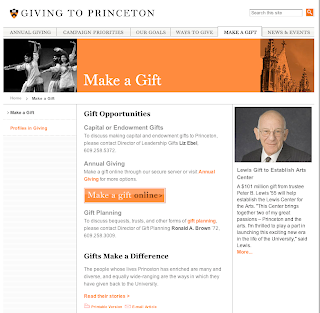DAVE
(hearing him)
Yes, Bob. Choices... Now the
Commerce Department..,
SECRETARY OF COMMERCE
(sitting erect)
Yes, Mr. President?
DAVE
(from a card)
You're spending forty-three million
dollars on an ad campaign to...
(reading)
'Boost consumer confidence in the
American auto industry.'
SECRETARY OF COMMERCE
And it's proving quite effective...
DAVE
Does it make the cars any better?
SECRETARY OF COMMERCE
No, sir. It's more of a perceptual
issue.
DAVE
(beat)
Perceptual?
SECRETARY OF COMMERCE
Yes, it's designed to bolster individual
confidence in a previous domestic
automotive purchase.
DAVE
(beat)
Why?
SECRETARY OF COMMERCE
Well... to shore up product
identification and preserve market
share.
DAVE
So we're spending forty-seven million
dollars to make people feel better
about a car they've already bought?
A slight digression...but this is really what development is all about. We're spending money to convince alums that their decision to go to school here was a good one so that they, in return, will give us money to spend on the next generation of students.
So how does the web fit into all this. Well, a good development website, in my opinion, has a number of tasks to achieve:
1) Provide alums with an easy way to make donations to the institution.
2) Acknowledge alums who have donated to give them a warm, fuzzy feeling.
3) Convince alums who are thinking about making a donation that it is a worthwhile venture through stories and iconic images.
4) Compliment ongoing marketing initiatives of the office that are taking place through other mediums.
When I first started my job back in November, I thought it would be a good idea to survey current development websites. Basically, I decided to go down the list of Top Colleges as ranked in US News and World Report. Here is the criteria I am looking at:
1) Does the main institution website link directly to the development website in a way that makes it easy for the user to give?
2) Does the development website do a good job of convincing me that my gift matters, no matter what the size?
3) Do they provide features that make me nostalgic about my institution or stories of students today that my gift will be benefitting?
4) Is making my gift easy?
5) Is my gift acknowledged?
Let's start off with the top dog themselves: Princeton. Princeton just launched a $1.75 billion campaign, Aspire.
1) Does the main institution website link directly to the development website in a way that makes it easy for the user to give?
Answer: Sort of.

Right now, the giving option is located in a quick links menu in a dropdown on the main page. To be fair, however, it looks like Princeton will be launched a new homepage with a more prominent giving button soon. Here is the preview:

Now I'll be honest: I'm a sucker for this website. I think it's clean, very easy on the eyes. I also love the bold orange on light grey...plus I think the grey just makes the images on the page pop out.
Answer: Yes, but you have to dig a little.
It's vital for colleges to be able to convince potentials donors that their gift matters, particularly with the younger classes. When we leave college, most of us just cannot afford to give any significant amount of money until at least a few years into our chosen career. At the same time, it's important for colleges to begin to cultivate that idea of philanthropy into their alums right off the bat so down the road when they can afford to give a lot more, it will be easy to sell them.
I'm actually a huge fan of how Princeton handles this on their site:
Even a small gift of $25 matters. If you are able to give more, it has a greater impact. Well done.
3) Do they provide features that make me nostalgic about my institution or stories of students today that my gift will be benefitting?
Answer: Ehhhh.....
I think this is where they start to fall short. I think the closest they come to meeting this goal is with their blog for the campaign, which I am a fan of:
Visit it at https://blogs.princeton.edu/aspire
The blog combines images of today with some pretty cool historical images and you can subscribe to it via e-mail. It's also easy to find, being linked directly off of http://giving.princeton.edu.
4) Is making my gift easy?
Answer: Yes
The "Make A Gift" button is clear in the top nav on the page and from there, you can make your online gift. Users can elect to log into an alumni account or just proceed to the gift form, which is broken up into four pages so that it doesn't overwhelm the user (this may seem like a small thing but just wait until we get to some other college sites....)
5) Is my gift acknowledged?
Answer: Ehhhh....
Although Princeton does offer a page with "profiles in giving" (pictured below), there is no full honor roll that I can see. Here, I think they are missing an opportunity. The honor roll on our page is one of the biggest drivers of traffic to the website (from people googling their name) and one of the biggest drivers of gifts (because people don't want to see their classmate's name listed and not theirs. Additionally, the profiles in giving only features high level donors, which is going to be an unreachable height for us mere mortals. Acknowledgment of only multi-million dollar gifts could work to undo any cultivation of younger classes, who may once again feel that their small gift won't matter:
Overall, I think we have to admit that Princeton does a damn good job. The site is clear, easy to navigate and seems built to handle most of the objectives a good development site should while also throwing in a bit of Web 2.0 here and there. Kudos to Princeton :-)









No comments:
Post a Comment